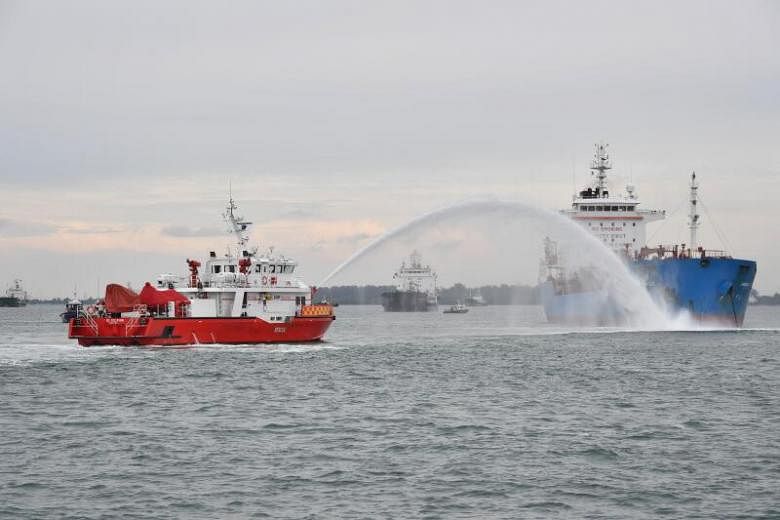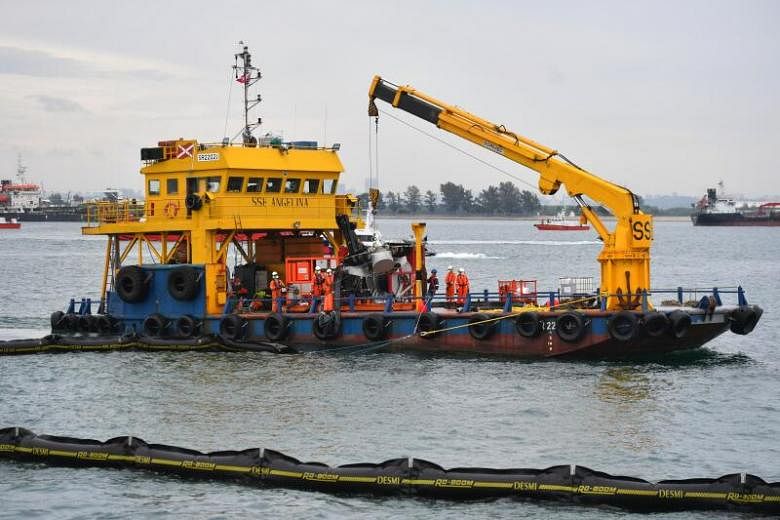New patrol craft from MPA display capabilities as first responder in oil spill exercise
1 of 3
An MPA first-responder craft at the scene of an "oil spill" incident in Raffles Anchorage on Sept 29, 2020. ST PHOTO: CHONG JUN LIANG

An SCDF vessel putting up a water curtain to prevent fires and disperse toxic fumes from an "oil spill" in an exercise on Sept 29, 2020. ST PHOTO: CHONG JUN LIANG

A Singapore Salvage Engineer vessel helping out in the oil spill exercise on Sept 29, 2020. ST PHOTO: CHONG JUN LIANG

Cara Wong
UPDATED
SEP 29, 2020, 05:43 PM
SINGAPORE - There was little time to waste as around 10,000 tonnes of crude oil had "spilt" after a collision of two oil tankers in Singapore's waters on Tuesday morning (Sept 29).
The Maritime and Port Authority of Singapore's (MPA) next-generation patrol craft sprung into action once they reached the scene, swiftly setting up portable water booms around the "oil spill" to prevent it from spreading, and deploying spraying systems to break up the oil particles.
The oil spill exercise enabled the new vessels, launched last month, to demonstrate their ability to manage such incidents more efficiently.
For example, one such vessel is able to deploy the water booms to contain the oil spill within half an hour. Previously, this process could take four to eight hours, said Senior Minister of State for Transport and Foreign Affairs Chee Hong Tat, who attended the exercise.
Speaking to the media after the exercise, he said: "That is a good first response to allow MPA, when they arrive on site, to be able to contain the oil spill before further reinforcements are called upon."
The exercise involved around 100 people from the MPA, the Police Coast Guard and the Singapore Civil Defence Force (SCDF), as well as private companies, including ExxonMobil Asia Pacific, Oil Spill Response and Singapore Salvage Engineers.
Some 15 vessels were involved in the exercise, including four next-generation patrol craft, and the SCDF's Marine Rescue Vessel and Rapid Response Fire Vessel, which put up a water curtain to prevent "fires" from erupting, and to disperse toxic fumes.
An "octopus" skimmer system was also used to skim the oil off the surface of the water, while drones were deployed to assess the situation from above.
Mr Chee said it is important to do such exercises regularly, as the agencies have to practise responding to different kinds of scenarios and incorporate new technology in their operations.
When asked if Singapore would be able to manage large-scale incidents like the Mauritius oil spill in July, which saw more than 1,000 tonnes of leaked fuel, Mr Chee said the authorities can learn from the best practices and mistakes that have been made.
"Learning and sharing, I think, are very important ways to help everyone... deal with oil spills better."
Last edited:


